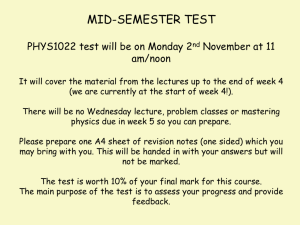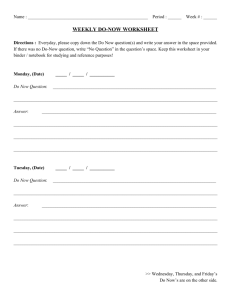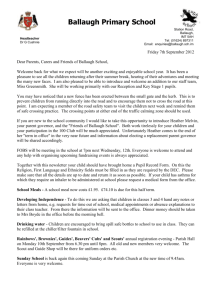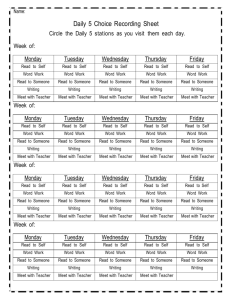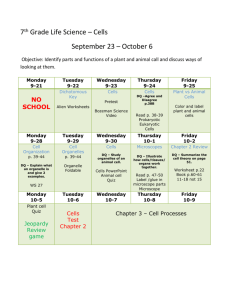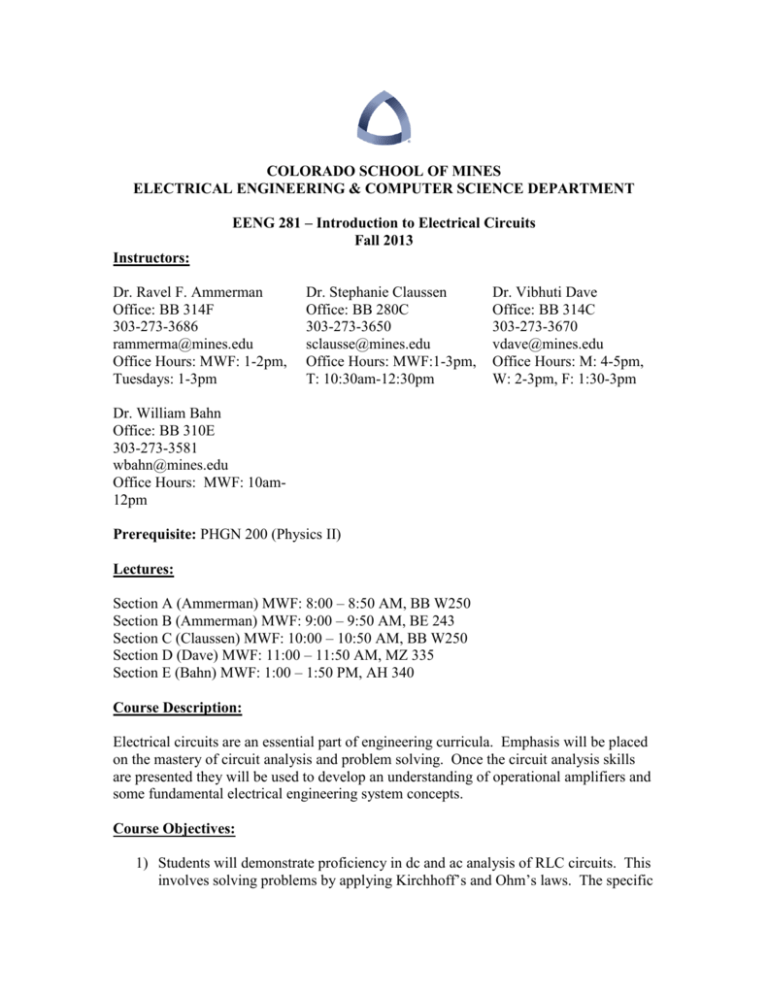
COLORADO SCHOOL OF MINES
ELECTRICAL ENGINEERING & COMPUTER SCIENCE DEPARTMENT
EENG 281 – Introduction to Electrical Circuits
Fall 2013
Instructors:
Dr. Ravel F. Ammerman
Office: BB 314F
303-273-3686
rammerma@mines.edu
Office Hours: MWF: 1-2pm,
Tuesdays: 1-3pm
Dr. Stephanie Claussen
Office: BB 280C
303-273-3650
sclausse@mines.edu
Office Hours: MWF:1-3pm,
T: 10:30am-12:30pm
Dr. Vibhuti Dave
Office: BB 314C
303-273-3670
vdave@mines.edu
Office Hours: M: 4-5pm,
W: 2-3pm, F: 1:30-3pm
Dr. William Bahn
Office: BB 310E
303-273-3581
wbahn@mines.edu
Office Hours: MWF: 10am12pm
Prerequisite: PHGN 200 (Physics II)
Lectures:
Section A (Ammerman) MWF: 8:00 – 8:50 AM, BB W250
Section B (Ammerman) MWF: 9:00 – 9:50 AM, BE 243
Section C (Claussen) MWF: 10:00 – 10:50 AM, BB W250
Section D (Dave) MWF: 11:00 – 11:50 AM, MZ 335
Section E (Bahn) MWF: 1:00 – 1:50 PM, AH 340
Course Description:
Electrical circuits are an essential part of engineering curricula. Emphasis will be placed
on the mastery of circuit analysis and problem solving. Once the circuit analysis skills
are presented they will be used to develop an understanding of operational amplifiers and
some fundamental electrical engineering system concepts.
Course Objectives:
1) Students will demonstrate proficiency in dc and ac analysis of RLC circuits. This
involves solving problems by applying Kirchhoff’s and Ohm’s laws. The specific
circuit analysis techniques of voltage and current division, node-voltage, meshcurrent, superposition, and Thevenin’s theorem will be emphasized. Mastering
the frequency domain concepts of phasors and impedance will be required to
analyze ac circuits.
2) Students will demonstrate an understanding of operational amplifiers (ideal and
non-ideal). Emphasis will be placed on an understanding of the basic structure of
these devices, circuit modeling, and their operation in circuits.
3) Students will demonstrate proficiency in the transient analysis of RC, RL, and
RLC circuits.
4) Students will demonstrate an understanding of basic power concepts in ac and dc
circuits. Maximum power transfer, ideal transformers, and electrical safety will be
emphasized.
Blackboard:
Given that Blackboard will be used to disseminate information about the course, it is
important that you regularly log into the system. Solutions to assigned problems will be
posted after the homework is collected.
Required Textbook:
The required text for the course is: Electric Circuits, by James W. Nilsson and Susan A.
Riedel, Ninth Edition, Pearson/Prentice-Hall, © 2011 (ISBN-13: 978-0-13-611499-4).
We will also be using the MasteringEngineering feature that Pearson Publishing provides,
so you will need to purchase an access code card too. The required textbook material is
also available from the Pearson Custom Library at a reduced cost. The CSM bookstore
carries the custom text with the MasteringEngineering access code cards. The ISBN for
the EENG 281 course is 1256555053. The text should be used to supplement the lecture
material. Carefully reading the text and working the example problems is an important
part of learning the fundamentals of this course.
Homework and Quizzes:
Homework will be assigned on a weekly basis, consisting of an online assignment
(submitted using the Pearson Publishing MasteringEngineering platform) as well as a
handwritten assignment. No late assignments will be accepted! All of the
MasteringEngineering online homework assignments are due Wednesday at 5:00pm.
Handwritten homework assignments are due each Wednesday at the beginning of class.
The first homework assignment is due on Wednesday, August 28, 2013. After the
homework has been collected, solutions will be posted on Blackboard.
A few short quizzes may be given during the semester based on the assigned homework
problems. You may use your textbook and notes during these quizzes.
MasteringEngineering:
Each student will solve and submit the homework problems online using
“MasteringEngineering” website. The textbook package contains a personalized access
code for a student to login as a “New Student”. Each student must register for
“MasteringEngineering” at http://www.masteringengineering.com. Click on courses and
select “EENG281 - Introduction to Circuits - Fall 2013” and enter the course ID
“EENG281CIRCUITSFALL2013”.
Piazza:
Piazza will be used to assist with student questions. Students from any section can ask
questions pertaining to problems or material discussed in class, homework problems, and
review questions before the exams, etc. Separate folders have been created so that
questions pertaining to a certain topic can be found in the same place. In order to protect
privacy, Piazza allows students to post questions anonymously. Students from any
section can answer questions posted by anybody. All four instructors will be able to view
the questions and provide their own answers. This will ensure quicker turnaround time on
student questions since there is a higher probability someone will answer it. In addition,
students are also allowed to send questions to individual instructors instead of posting it
for everyone to see.
Find our class page at: https://piazza.com/mines/fall2013/eeng281/home
Grading:
The grade you receive in this course will be based on the following:
MasteringEngineering Homework
Handwritten Homework
Short Quizzes/Instructor Discretion
2 Exams @ 25% each
Final Exam
10%
10%
5%
50%
25%
Total
100%
Grade allocation for the course will be as shown in the table below:
A ( >90)
B+ ( 83 –85)
C+ ( 73 –75)
D+ ( 63 –65)
F < 55
A– (86 - 89)
B (80 – 82)
C (70 – 72)
D (60 – 62)
B– ( 76 –79)
C– ( 66 –69)
D– ( 56 –59)
Attendance:
Excessive absences will result in a lowered and possibly even failing grade. Any short
quizzes given during class may only be made up if you have an excused absence.
Colorado School of Mines Academic Dishonesty Policy:
The consequences for academic dishonesty at the Colorado School of Mines are severe
and can lead to expulsion. The CSM culture requires that you take responsibility for your
education in a responsible manner and adhere to the academic dishonesty policy.
The policy on homework is that it is perfectly acceptable for groups to work on the
homework together. However, all students must turn in individual homework (unless
otherwise stated) and they must understand what they turn in. Copying of solutions
without understanding them is not allowed; if a student copies a solution and cannot
explain it adequately this is considered academic dishonesty. For computer exercises
each student is expected to generate his/her own solution (i.e. one cannot simply copy
another person’s computer solution and modify it slightly to make it look like it is your
own work).
For laboratories, again students can work in groups but must understand all aspects of the
laboratory. Representation of calculated data (i.e. dry lab) as measurements is considered
academic dishonesty.
During exams, students must do 100 percent of the work on their own.
EENG 281 – Introduction to Electrical Circuits
Fall 2013 Course Schedule
Class
1
Date
Wednesday,
August 21
Lecture Topic
Course Introduction
Circuit Fundamentals
Voltage & Current
Sources
Resistors & Ohm’s Law
Reading
Chapter 1
Pages 2 – 18
2
Friday,
August 23
3
Monday,
August 26
Kirchhoff’s Laws
Wednesday,
August 28
Simple Resistive Circuits
Series & Parallel
Voltage Divider and
Current Divider Circuits
Chapter 3
Pages 60 – 70
Friday,
August 30
Monday,
September 2
Measurements
Delta-Wye Transforms
Introduction to the
Node-Voltage Method
Chapter 3
Pages 71 – 80
Chapter 4
Pages 96 − 107
4
5
6
Chapter 2
Pages 26 – 38
Chapter 2
Pages 39 – 50
7
Wednesday,
September 4
Introduction to the
Mesh-Current Method
Chapter 4
Pages 108 − 114
8
Friday,
September 6
Node-Voltage Method
Versus
Mesh-Current Method
Chapter 4
Pages 115 – 117
9
Monday,
September 9
Source Transformations
Chapter 4
Pages 118 – 120
10
Wednesday,
September 11
Thévenin & Norton
Equivalent Circuits
Chapter 4
Pages 121 – 124
11
Friday,
September 13
Chapter 4
Pages 125 – 127
12
Monday,
September 16
Thévenin and Norton
Equivalent Circuits
Maximum Power
Transfer Theorem
Superposition Principle
13
Wednesday,
September 18
Introduction to
Operational Amplifiers
Chapter 5
Pages 156 – 163
Friday,
September 20
Monday,
September 23
Operational Amplifier
Applications
Operational Amplifier
Applications
Chapter 5
Pages 164 – 170
14
15
Homework Assignment
MasteringEngineering HW
(Online Assignment)
Written HW
Chapter 1: 14,26
Chapter 2: 7,21
MasteringEngineering HW
(Online Assignment)
Written HW
Chapter 3: 7,10,25,58
MasteringEngineering HW
(Online Assignment)
Written HW
Chapter 4: 15,27,38,61
Chapter 4
Pages 128 – 137
MasteringEngineering HW
(Online Assignment)
Written HW
Chapter 4: 64,65,69,79,92
Class
Date
Lecture Topic
Reading
16
Wednesday,
September 25
Operational Amplifiers
Non-Ideal Models
Chapter 5
Pages 171 − 176
Friday,
September 27
Monday
September 30
Tuesday,
October 1
Wednesday,
October 2
Friday,
October 4
Monday,
October 7
Operational Amplifiers
Non-Ideal Models
17
18
19
REVIEW for EXAM 1
Exam 1 (6:30-8:00pm)
Chapters 1 - 5
No Class
Inductance and
Capacitance
Magnetically Coupled
Circuits
Chapter 6
Pages 190 – 204
Chapter 6
Pages 205 – 213
Wednesday,
October 9
Mutual Inductance
Energy Calculations
Chapter 6
Pages 214 – 220
Friday,
October 11
Monday
October 14
Transient Response
First-Order Circuits
Chapter 7
Pages 232 – 250
Wednesday,
October 16
Transient Analysis
Step-by-Step Procedure
Chapter 7
Pages 251 – 255
Friday,
October 18
Monday,
October 21
Transient Analysis
Sequential Switching
Transient Analysis
Unbounded Response
Chapter 7
Pages 256 – 259
Chapter 7
Pages 260 – 261
27
Wednesday,
October 23
Natural and Step
Responses of Parallel
RLC Circuits
Chapter 8
Pages 286 – 307
28
Friday,
October 25
Natural and Step
Responses of Series
RLC Circuits
Chapter 8
Pages 308 – 311
29
Monday,
October 28
RLC Circuit Analysis
20
21
22
23
24
25
26
Homework Assignment
MasteringEngineering HW
(Online Assignment)
Written HW
Chapter 5: 6,26,36,39
MasteringEngineering HW
(Online Assignment)
Written HW
Chapter 5: 43,45,46,47
Fall Break
MasteringEngineering HW
(Online Assignment)
Written HW
Chapter 6: 2,17,26,43,45
MasteringEngineering HW
(Online Assignment)
Written HW
Chapter 7: 4,35,43,52,70,84
Class
30
31
32
33
34
35
36
37
38
39
40
41
42
43
Date
Wednesday,
October 30
Friday,
November 1
Monday,
November 4
Wednesday,
November 6
Friday,
November 8
Monday,
November 11
Wednesday,
November 13
Thursday,
November 14
Friday,
November 15
Monday,
November 18
Wednesday,
November 20
Friday,
November 22
Monday,
November 25
Wednesday,
November 27
November
28-29
Monday,
December 2
Wednesday,
December 4
Lecture Topic
Sinusoidal Sources
Phasors & Impedance
Phasors & Impedance
Reading
Homework Assignment
Chapter 9
Pages 330 – 340
MasteringEngineering HW
(Online Assignment)
Written HW
Chapter 8: 18,29,30,31,50
(Please also include a graph
for 8.29, 8.30, and 8.31)
Chapter 9
Pages 341 – 344
Chapter 9
Pages 345 – 352
Steady-State AC
Sinusoidal Analysis
Steady-State AC
Sinusoidal Analysis
Steady-State AC
Sinusoidal Analysis
Complex Numbers
Problem Set
MasteringEngineering HW
(Online Assignment)
Written HW
Chapter 9: 11,12,27,28,29
REVIEW for EXAM 2
Exam 2 (6:30-8:00pm)
Chapters 5-9
No Class
Ideal Transformers
Ideal Transformers
Chapter 9
Pages 359 − 371
MasteringEngineering HW
(Online Assignment)
Written HW
Chapter 9: 44,46,54,60,71
Electrical Safety
Electrical Safety
Residential Wiring
No Class
Thanksgiving
Residential Wiring
REVIEW for FINAL
Ideal Transformers, Electrical
Safety, and Residential Wiring
Problem Set

